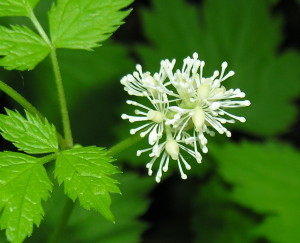It is a herbaceous perennial plant growing 30-60 cm tall. It has toothed, bipinnate compound leaves up to 40 cm long and 30 cm broad. The flowers are white, with 4-6 petaloid sepals, and are produced in an erect raceme about 10 cm long. The fruit is an oval glossy black berry, 10-11 mm long and 8 mm diameter.
There are two varieties:
- Actaea spicata var. spicata. Europe, northwestern Asia; at 0-1900 m altitude.
- Actaea spicata var. acuminata (syn. A. acuminata). Southwestern Asia, Himalaya, at 2500-3700 m altitude.
Contents
Uses
- Despite being poisonous, when carefully measured and treated, it was used in the past in herbal medicines. It is also grown as an ornamental plant in gardens.
The berries contain cardiogenic toxins which can have an immediate sedative effect on human cardiac muscle tissue, and are the most poisonous part of the plant. Ingestion of the berries can lead to cardiac arrest and death. The berries are harmless to birds, the plants’ primary seed dispersers
Benefits
- Actea Spicata is beneficial for treating rheumatism, and especially rheumatism from the smaller knees and lower back. Rheumatic pain around tiny joints, including hand, fingers, ankles, feet. Actea Spicata treat inflammation and general body weakness.
- Tea from its roots can heal throat inflammation and coughs.
- Its roots are advantageous for menstrual disorders and menopause.
Cautions
- Actaea spicata has to be prescribed by a professional, as some of its parts are poisonous and patients should be careful with its intake.
Interactions
- There are no interactions listed for Actaea spicata.
Other names
Baneberry
References
Source: Wikipedia, https://en.wikipedia.org/wiki/Actaea_spicata
Homeo4happylife, http://www.homeo4happylife.com/2012/08/symptoms-and-uses-of-actaea-spicata.html

